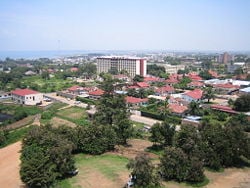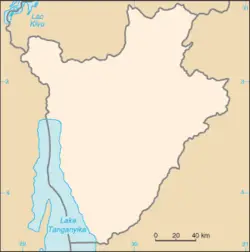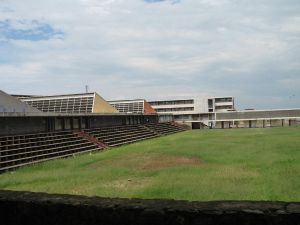Bujumbura
| Bujumbura, Burundi | |
| Central Bujumbura, with Lake Tanganyika in the background | |
| Coordinates: {{#invoke:Coordinates|coord}}{{#coordinates:3|23|00|S|29|22|00|E|type:city | |
|---|---|
| name= }} | |
| Province | Bujumbura-Ville |
| Population (1994) | |
| - City | 300,000 |
| - Urban | 300,000 |
| estimated | |
| Time zone | CAT (UTC+1) |
| - Summer (DST) | none (UTC+1) |
Bujumbura (pronounced /ˌbuːdʒəmˈbuːrə/), the capital city of Burundi, lies at the northeastern corner of Lake Tanganyika and is Burundi's largest city and its administrative, communications, and economic center. Manufactures include textiles and soap. Bujumbura is Burundi's main port and ships most of the country's chief export, coffee, as well as cotton, skins, and tin ore.
Geography
Etymology of name – if available. Topography: Physical qualities of a particular place. Example: Mexico City a. Mountain flanked basin b. on dry lake bed c. vulnerability to earthquakes d. trapped air pollution (also true in L.A. and Athens) Elevation Climate (not required unless it makes the city a resort) Rivers and canals Size – land area, size comparison Environmental issues Districts
History
Bujumbura grew from a small village after it became a military post in German East Africa in 1889. After World War I it was made the administrative center of the Belgian League of Nations mandate of Ruanda-Urundi. The city's name was changed from Usumbura to Bujumbura when Burundi became independent in 1962. Since independence, Bujumbura has been the scene of frequent fighting between the country's two main ethnic groups, with Hutu militias opposing the Tutsi-dominated Burundi army.
The city center is a colonial town with a large market, the national stadium, a large mosque, and the cathedral for the Archdiocese of Bujumbura. Museums in the city include the Burundi Museum of Life and the Burundi Geological Museum. Other nearby attractions include the Rusizi National Park, the Livingstone-Stanley Monument at Mugere (where David Livingstone and Henry Morton Stanley visited 14 days after their first historic meeting at Ujiji in Tanzania), and the source of the southernmost tributary of the Nile, described locally as the source of the Nile.
Ferries sail from Bujumbura to Kigoma in Tanzania, while the city is also home to the Bujumbura International Airport and the University of Bujumbura.
The city is also where a lot of the Disney movie George of the Jungle is supposed to take place (though the film's location bears very little resemblance to the real city).
Government
Economy
Overview – Any specialization: For instance, is a manufactured product is associated with particular cities a. Milwaukee—cheese and beer b. Los Angeles—entertainment industry c. Sheffield—coal d. top 20 cities in the U.S. are highly specialized
Per capita GDP, rank Financial and business services sector Tourism Manufacturing Transport: Road, rail, air, sea
Demography
Bujumbura had an estimated population of 300,000 in 1994. Race/ethnicity - historical background of ethnic groups Language Religion Colleges and universities
Maps
Statistics
- Elevation = 794.0 m (2,605 ft)
- Population = 187,297
ReferencesISBN links support NWE through referral fees
External links
Official Bujumbura's Website www.villedebujumbura.org
Credits
New World Encyclopedia writers and editors rewrote and completed the Wikipedia article in accordance with New World Encyclopedia standards. This article abides by terms of the Creative Commons CC-by-sa 3.0 License (CC-by-sa), which may be used and disseminated with proper attribution. Credit is due under the terms of this license that can reference both the New World Encyclopedia contributors and the selfless volunteer contributors of the Wikimedia Foundation. To cite this article click here for a list of acceptable citing formats.The history of earlier contributions by wikipedians is accessible to researchers here:
The history of this article since it was imported to New World Encyclopedia:
Note: Some restrictions may apply to use of individual images which are separately licensed.




